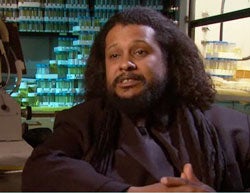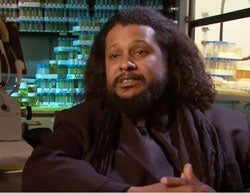 KINGSTON, R.I. – September 19, 2008 — Tyrone B. Hayes, a renowned biologist who has focused international attention on the human dangers of the widely used herbicide, Atrazine, will deliver the keynote address during the University of Rhode Island’s 12th annual Diversity Week.
KINGSTON, R.I. – September 19, 2008 — Tyrone B. Hayes, a renowned biologist who has focused international attention on the human dangers of the widely used herbicide, Atrazine, will deliver the keynote address during the University of Rhode Island’s 12th annual Diversity Week.
On Thursday, Sept. 25, at 7:30 p.m. Hayes’ lecture, “From ‘Silent Spring’ to Silent Night: The Silent Attack of Pesticides on the Human Immune System,” will focus on his controversial research findings. Free and open to the public, the lecture will be held in the Memorial Union Ballroom, 50 Lower College Road, Kingston Campus. The talk is co-sponsored by Lifespan and URI’s Multicultural Center.
Hayes has been described as following the path blazed by Rachel Carson in her studies of the pesticide DDT in 1962. When the global agribusiness Syngenta commissioned his lab at the University of California at Berkeley to research the effects of environmental exposure to Atrazine, its top-selling product in 1997, it had no idea just how disruptive the results on its endocrine-disrupting herbicide would be.
Hayes studied the effects of Atrazine on frogs, which have similar endocrine systems to humans and are widely regarded as important proxies in predicting changes in human growth, development, reproduction, and immune function. His research showed that low dosages of Atrazine interfered with normal hormone functions in male frogs, resulting in heightened stress, hyperactivity, and immune suppression, followed by delayed maturation, increased vulnerability to disease and mortality, abnormal changes in sexual and reproductive characteristics, and increased susceptibility to disease and mortality.
These same effects are associated with Atrazine exposure in humans. Hayes’ results set the stage for a classic David and Goliath struggle, pitting the biologist and his allies in the academic and nonprofit worlds against the giant corporation, its researchers, and its allied farmers.
One of the nation’s most widely used pesticides, Atrazine is most hazardous because it is commonly applied to ground surfaces and washed into the water supply. American farmers and gardeners apply more than 80 million pounds annually to control weeds and lessen soil erosion. It is commonly used to treat corn, sugarcane, sweet corn, harvested sod, and hay and seed crops.
Seeking to evaluate the environmental safety of Atrazine in 2003, the U. S. Environmental Protection Agency examined 17 studies, most of them funded by Syngenta, in concluding that “the weight of the evidence” favored the continued public use of Atrazine. However, in 2004, the European Union banned the use of Atrazine, citing the need for caution because of concerns about groundwater contamination.
A first generation college student from South Carolina, Hayes earned a bachelor’s degree in biology from Harvard University in 1989, and a doctorate in integrative biology from the University of California at Berkeley in 1993. In 2002, he was promoted to the rank of professor at age 35, the youngest person to do so in the history of his department.
In 2001, National Geographic selected Hayes as one of nine visionary explorers who are making significant contributions to world knowledge while still early in their careers. In 2005, he was one of five recipients of the Jennifer Altman Award for Integrity in Science and the Public Interest.
Other sponsors of the lecture include URI’s Office of the President, the Office of the Provost, the Division of Student Affairs, the Diversity Week Planning Committee, Kappa Delta Pi Honors Society, and the Multicultural Unity and Student Involvement Council. For more information, call 401-874-2851 or visit www.uri.edu/mcc.
Watch an interview with Professor Hayes (6 minutes) about his research into the effects of the pesticide Atrazine on frogs posted online at KQED, Northern California Public Broadcasting Network. The interview aired May 6, 2008.

